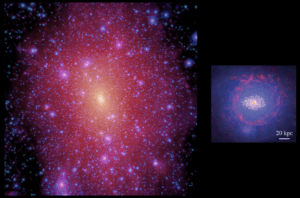
Side-by-side image of a simulated dark matter halo (left) and its galaxy (right), shown roughly to scale. Galaxies sit deep within the gravitational wells of their dark matter halos and typically make up only a few percent of their halo’s total mass and size. While halos themselves are invisible, galaxies are not — so can we use what we observe about galaxies to learn about the hidden proper-ties of their dark matter halos?
The latest generation of astronomical surveys reveals an intricate cosmic web filled with structure on all scales. The basic building blocks of this structure are galaxies, which range in mass from small dwarfs (a few billion times the mass of the Sun) to giant galaxies (several trillion solar masses). On larger scales, galaxies gather into groups and massive galaxy clusters — the largest gravitationally bound structures in the Universe.
Galaxies shine through the light of their stars, but each galaxy sits inside an invisible halo of dark matter. This dark matter cannot be observed directly, but its presence is revealed by the motions of stars and gas. Dark matter halos typically outweigh their galaxies by factors of 10 to 1,000 and dominate their internal dynamics, strongly influencing the observable properties of galaxies.
How do galaxies and their halos coevolve?
And can we infer the hidden properties of dark matter halos from what we see in their galaxies?
This project aims to tackle these questions using cutting-edge cosmological simulations that follow the collapse of dark matter halos and the formation of galaxies from the Big Bang to the present day. The student will investigate how the observable properties of galaxies — such as their masses, sizes, and angular momentum — relate to the formation histories of their stars and dark matter halos.
These simulations are part of a major international collaboration involving researchers at UWA, the UK, and the Netherlands, and represent the current state of the art in theoretical galaxy formation.
| Student attributes | |
| Academic background | Physics/Astronomy |
| Computing skills | Python (desirable) |
| Project timeline | |
| Week 1 | Inductions and project introduction |
| Week 2 | Initial presentation |
| Week 3 | Analyse assembly histories of simulated dark matter haloes |
| Week 4 | Analyse assembly histories of simulated galaxies |
| Week 5 | Identify galaxy properties most sensitive to halo formation histories |
| Week 6 | Compare observable scaling relations of simulated galaxies that form within distinct halo populations |
| Week 7 | Compare scaling relations of “real” and simulated galaxies |
| Week 8 | Infer properties of dark matter haloes from observable properties of galaxies |
| Week 9 | Final presentation |
| Week 10 | Final report |